Cell division
1/48
There's no tags or description
Looks like no tags are added yet.
Name | Mastery | Learn | Test | Matching | Spaced |
|---|
No study sessions yet.
49 Terms
Cell cycle stages
Interphase (G1, S, G2) - longest stage
Nuclear division
Cytokinesis
G0
In this phase, cells may undergo apoptosis (programmed cell death), differentiation or
senescence.
Interphase G1
Cell grows
Protein synthesis occurs, RNA, enzymes
Organelles replicate
Preparation for s phase
G1 Checkpoint
Checks is cell has grown to correct size
Checks if DNA is damaged
Checks if cells have resources
Interphase S phase
DNA replicated for mitosis
46 Chromosomes 46 chromatids ———> 46 chromosomes 92 chromatids
When all chromosomes have been duplicated,
each one consists of a pair of identical sister
chromatids.
This phase is rapid, and because the exposed
DNA base pairs are more susceptible to
mutagenic agents, this reduces the chances of
spontaneous mutations happening.
Interphase G2
Cell grows
G2 Checkpoint
Special chemicals ensure that the cell is ready
for mitosis by stimulating proteins that will be
involved in making chromosomes condense
and in formation of the spindle.
Checks DNA is correclty replicated
Why are these checkpoints important?
to prevent uncontrolled division that would lead to tumours (cancer)
to detect and repair damage to DNA (for example, damage caused by UV light).
What does the specific sequence ensure?
The cycle cannot be reversed
The DNA is only duplicated once during each cell cycle.
Why is mitosis used?
Growth
Tissue repair
Asexual reproduction of single celled protoctists e.g. amoeba and paramecium to produce new individuals
Creates body cells
M phase
Cell growth stops
mitosis occurs
M phase checkpoint
Checks in metaphase
Makes sure chromosomes are lined up correctly in center
Checks chromosomes are attached to spindles correctly
What happens if cell does not meet checkpoint requirement?
Cell will pause in checkpoint until issue can be fixed
Will undergo apoptosis - if cannot be fixed (self - destructs) - ensures this cell cannot divide
Prophase
Replicated chromosomes consist of two pairs identical sister chromosomes
Chromosomes condense shorten and thicken - DNA supercoils
Nuclear envelope breaks down
Centrioles create spindle fibres
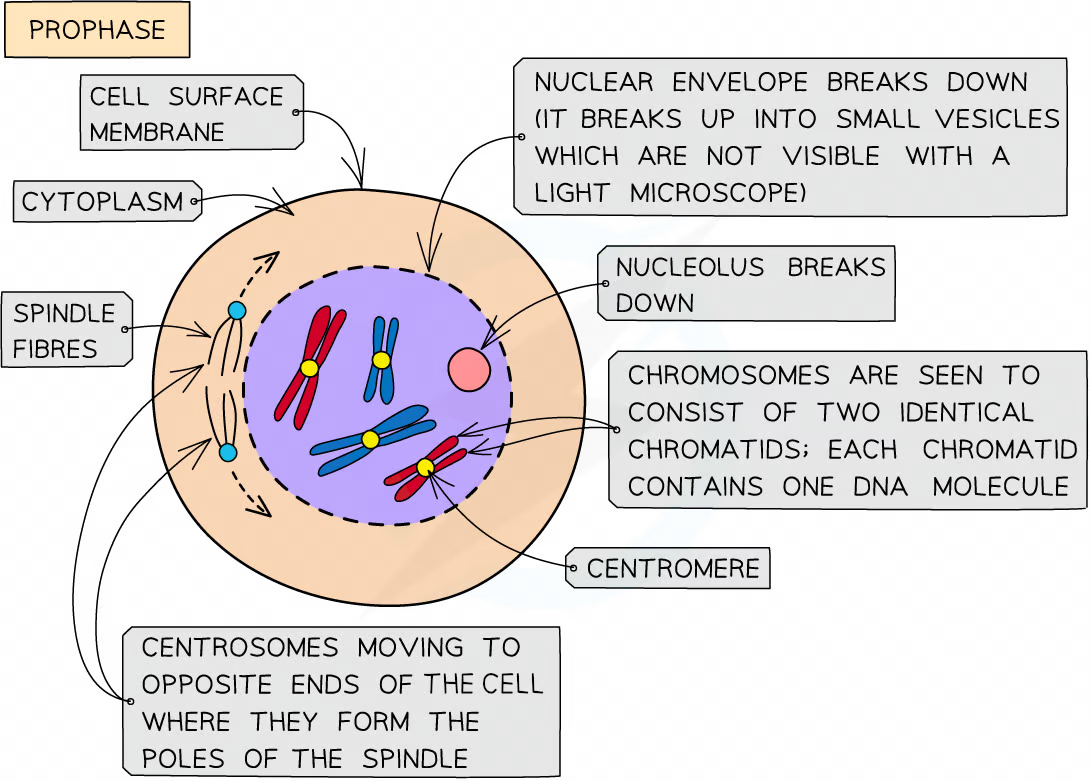
Metapahse
Chromosomes line up on equator spindle fibres attach to centromere
Checkpoint at this stage ensures every chromosome is attached to spindle correctly
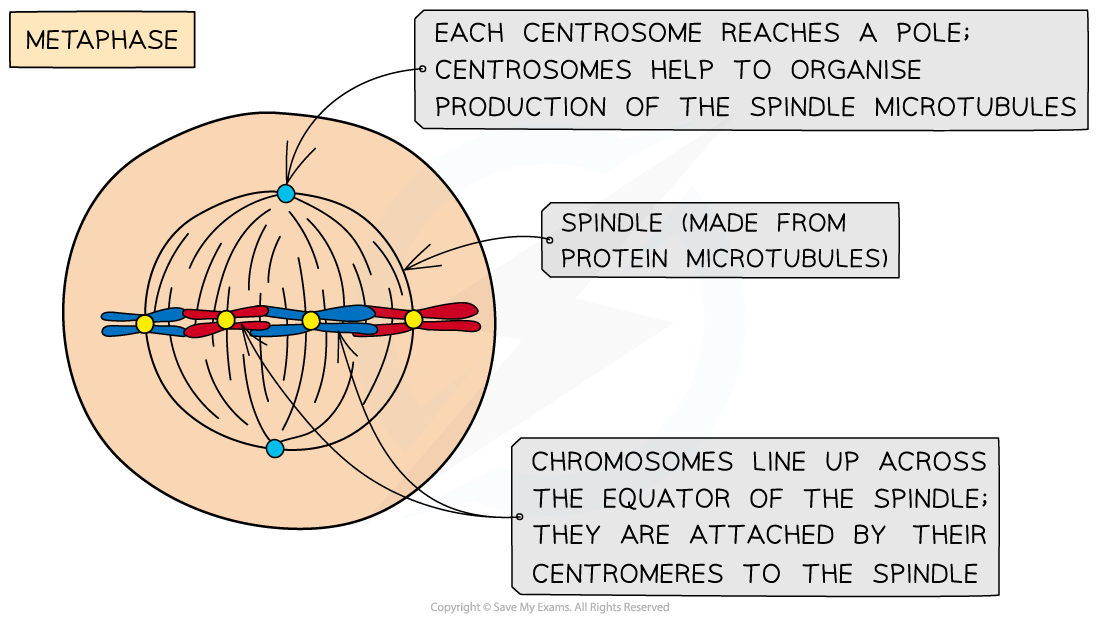
Anaphase
Spindle fibres contract and pull chromatids by centromeres to opposite poles
Chromosomes are separated by centromeres, and sister chromatids move to opposite ends
Needs energy - ATP
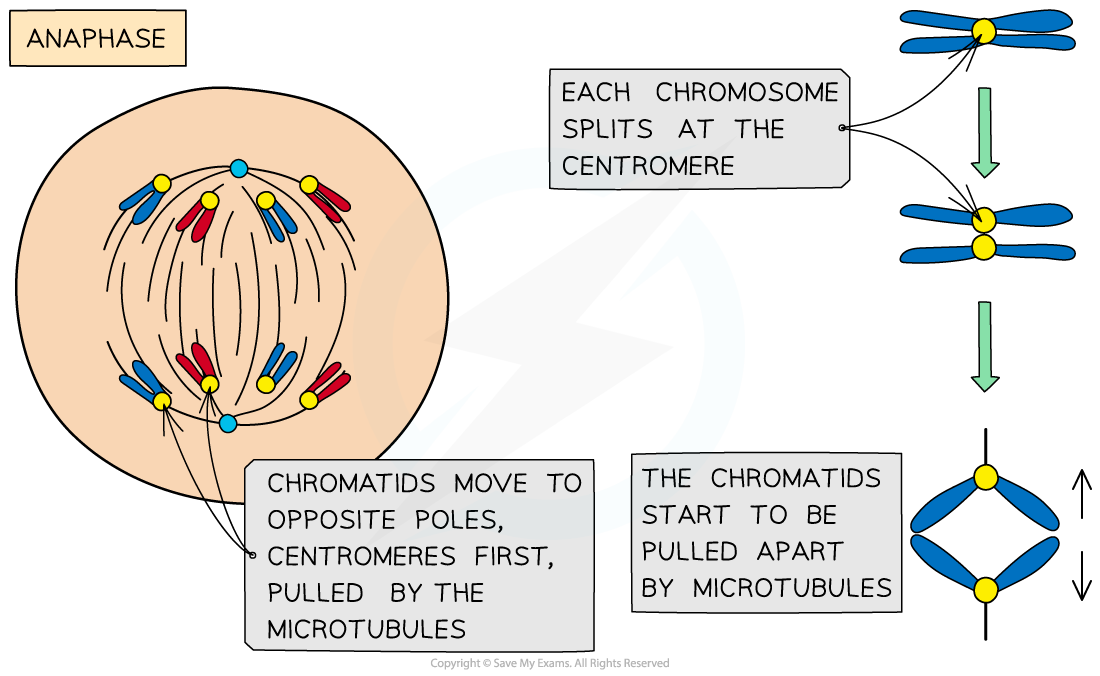
Telophase
Chromosomes become longer and thinner - no longer visible
Spindle fibres disintegrate, nuclear membrane forms
The cell now contains two nuclei each
genetically identical to each other and to the
parent cell from which they arose.
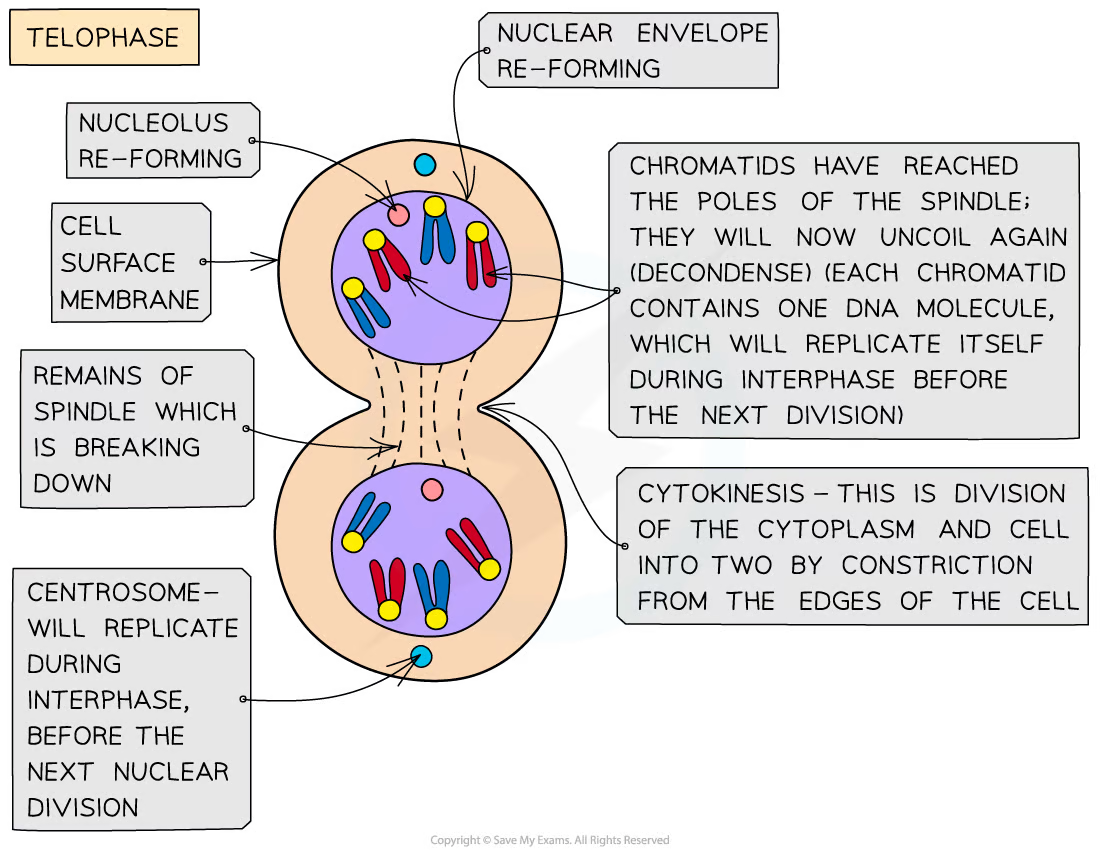
Cytokinesis
Cytoplasm splits - forms cleavage furrow forms in middle of cell
Cytoskeleton causes cell membrane to draw inwards until the cell splits in two
Plant cells - cell membrane splits due to fusing of golgi apparatus vesicles. Cell wall forms new sections around membrane
Observing mitosis
Visible under light microscope in onion garlic and root tips
A thin slice of root tip is placed on a microscope slide and broken down with a needle
An acetic orcein stain is added (which stains chromosomes) - makes visible
Cover slip is pushed down - to squash tip to ensure a single layer of cells so light can pass through
Mitotic index
The number of cells in mitosis/ total number of cells x 100
Meiosis
Two nuclear divisions - resulting in 4 genetically different haploid daughter cells
Haploid n = one copy of chromosomes 23
Diploid 2n = two copies of chromosomes 46
Creates - Gametes - haploid as they fuse together - as a fertilised egg they have 46
Reduction division - starting cells has 46 chromosomes - sperm and egg cells have only 23
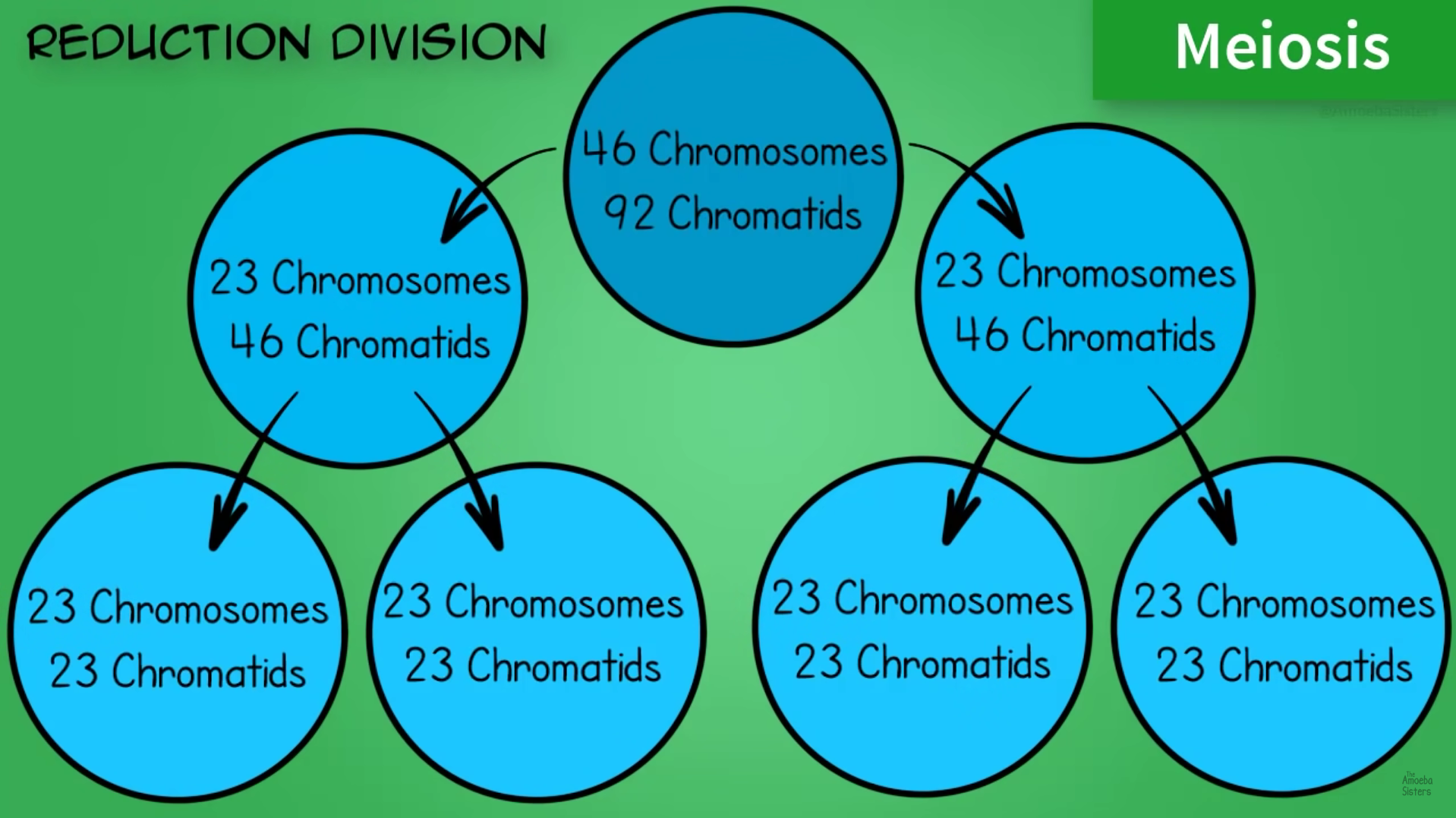
How are genetic differences introduced
Crossing over
Independent assortment
Any sperm can fertilise egg
Significance of meiosis
Sexual reproduction increases genetic variation
This increases its chances of survival with environment changes and selctional pressures
Gives some individuals characteristics that enable them to be better adapted to the
change.
Interphase
DNA replicates - 46 chromosomes and 46 chromatids - 46 chromosomes and 92 chromatids
Cell growth
Prophase 1
Replicated chromosomes consist of two identical sister chromosomes
Chromosomes condense shorten and thicken - DNA supercoils
Nuclear envelope breaks down
Centrioles create spindle fibres
Homologous pairs (bivalent) line up - same size contain same genes in same location
Non - sister chromatids cross over - forming chiasma and transfer genetic information - new combination of alleles to form recombinant chromosomes
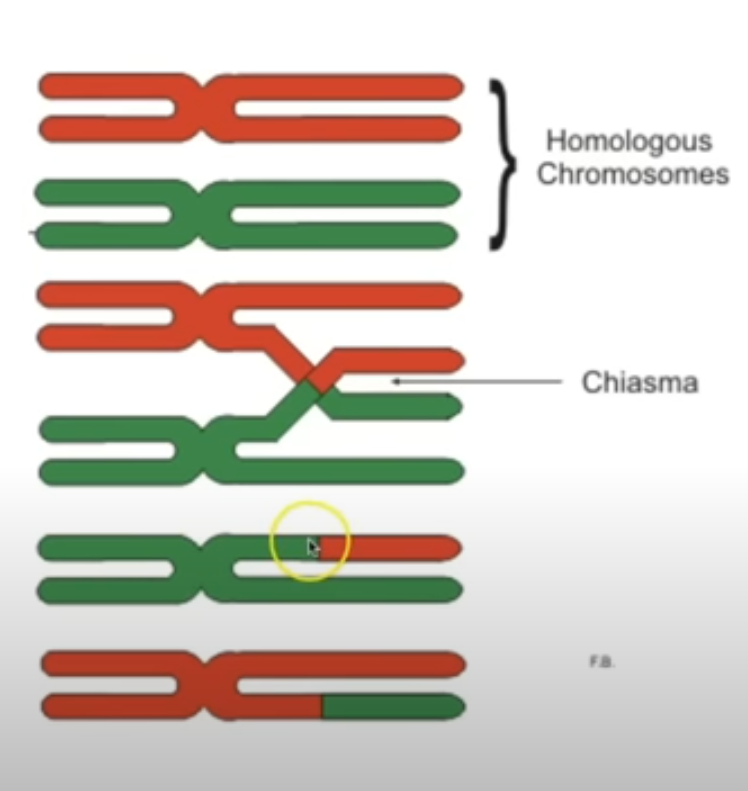
Metaphse 1
Homologous pairs line up on equator spindle fibres attach to centromere
Checkpoint at this stage ensures every chromosome is attached to spindle correctly
Independent assortment - homologous pairs line up in random order of maternal and paternal chromosomes
2²³ combinations

Anapahse 1
Spindle fibres contract and pull Chromosomes by centromeres to opposite poles
Needs energy - ATP
Telophase 1
Cytoplasm splits - forms cleavage furrow forms in middle of cell
Chromosomes become longer and thinner - no longer visible
Spindle fibres disintegrate, nuclear membrane forms
There is then a short
interphase when the chromosomes uncoil.
Cytokinesis
Cytoskeleton causes cell membrane to draw inwards until the cell splits in two set of
chromosomes
Each new nucleus contains half the original number of chromosomes, but each chromosome consist of two chromatids
Prophase II
If the nuclear envelopes have reformed, then they now break down.
The chromosomes coil and condense, each one consisting of two chromatids.
The chromatids of each chromosome are no longer identical, due to crossing over in prophase 1.
Metaphase II
Chromosomes line up in the middle
Anphase II
The centromeres divide
The chromatids of each chromosome are pulled apart by motor protein that drag them along the tubulin threads of the spindle, towards opposite poles.
Telophase II
Nuclear envelopes form around each of the four haploid nuclei.
cells now divide to give four haploid cells
Entrhocytes
Erythrocytes carry oxygen from the lungs to respiring cell
Derive from stem cells in the bone marrow
Large SA:V ratio - very small - oxygen to diffuse across their membranes and easily reach all regions inside the cell.
Biconcave shape to increase surface area
Well developed cytoskeleton to increase cell flexibility to fit through narrow capillaries
No nucleus to create more space for haemoglobin in oxygen transport
Neutrophils
Neutrophils make up about 50% of the white blood cells in your body
Have a lobed nucleus to squeeze through capillary walls
Flexible to surround and engulf pathogens
They are attracted to and travel towards infection sites by chemotaxis.
Have lysosomes which contain lyysozymes
Spermatoza
The many mitochondria carry out aerobic respiration. The ATP provides energy for locomotion of the tail to propel the cell towards the ovum.
Sperm cells are small but long and thin, they can move easily.
• Once the sperm reaches an ovum, digestive enzymes are released from the acrosome
The enzymes digest the outer protective covering of the ovum, allowing the sperm head to enter the ovum.
The head of the sperm contains the haploid male gamete nucleus and very little cytoplasm.
Palisade cells
Adapted for photosynthesis
• they contain many chloroplasts – the organelles that carry out photosynthesis
They have a large vacuole so that the chloroplasts are positioned nearer to the periphery of the cell, reducing the diffusion distance for carbon dioxide
Thin cell walls with little space between for CO2 to diffuse in
Root hair cells
The hair-like projection greatly increases the surface area for absorption of water and mineral ions, such as nitrates, from
The root hair cells have special carrier proteins in the plasma membranes in order to actively transport the mineral ions in.
These cells will also produce ATP, as this is needed for active transport
Guard cells
Flexible cell wall - thicker inner wall cells bend when turgid to open stomata and close when flaccid to control water loss by transpiration
In spongy mesophyll with air spaces for oxygen to diffuse out
Squamous epithelial cells
Single layer of flat cells for a short diffusion distance
Ciliated epithelial cells
Hair like projections sway away mucus from lungs
Goblet cells release mucus to trap dust and pathogens
Cartilage
Firm and flexible provides structural support
Prevents bones rubbing together - causes damage
Muscle
Tissues can contract and relax for movement
Xylem
Elongated tissue, hollow dead cells -
Wide lumen higher volume of water
lignin strengthens and makes walls waterproof
Madoe of meristem tissue
Phloem
Made of sieve tube elements, perforated end walls and lacking most organelles to make transport easier
Companion cells provide resources - sucrose
Made of meristem tissue
Totipotent
Cells can divide into any type of body cell. Occur only for limited time in embryos
Pluripotent
Cells can divide into any type of cells apart from placenta
Used in research - to cure disorders
If doesn’t work can continually divide into tumour
Ethical issues destroying embryo after
Multipotent
Found in mature mammals
Differentiate into limited cells e.g. blood cells
Unipotent
Can only divide into one type of cell